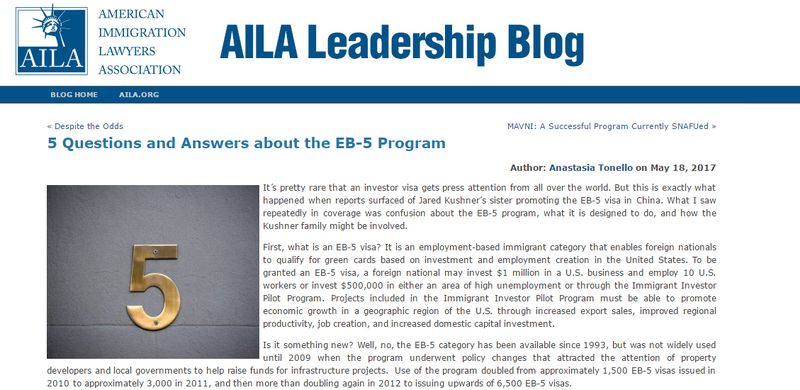5 Questions and Answers about the EB-5 Program
It’s pretty rare that an investor visa gets press attention from all over the world. But this is exactly what happened when reports surfaced of Jared Kushner’s sister promoting the EB-5 visa in China. What I saw repeatedly in coverage was confusion about the EB-5 program, what it is designed to do, and how the Kushner family might be involved.
First, what is an EB-5 visa? It is an employment-based immigrant category that enables foreign nationals to qualify for green cards based on investment and employment creation in the United States. To be granted an EB-5 visa, a foreign national may invest $1 million in a U.S. business and employ 10 U.S. workers or invest $500,000 in either an area of high unemployment or through the Immigrant Investor Pilot Program. Projects included in the Immigrant Investor Pilot Program must be able to promote economic growth in a geographic region of the U.S. through increased export sales, improved regional productivity, job creation, and increased domestic capital investment.
Is it something new? Well, no, the EB-5 category has been available since 1993, but was not widely used until 2009 when the program underwent policy changes that attracted the attention of property developers and local governments to help raise funds for infrastructure projects. Use of the program doubled from approximately 1,500 EB-5 visas issued in 2010 to approximately 3,000 in 2011, and then more than doubling again in 2012 to issuing upwards of 6,500 EB-5 visas. Currently, approximately 10,000 EB-5 visas are issued annually, nearly 7,000 of which are issued to Chinese nationals. Successful EB-5 funded projects include Manhattan’s Hudson Yards, Brooklyn’s Pacific Park (Atlantic Yards), San Francisco’s Hunters Point Shipyard, and Las Vegas’ SLS Las Vegas Hotel and Casino. EB-5 funding provided much needed capital to these and other projects which may not have otherwise been able to break ground.
Where do the Kushners fit in? As a prominent real estate family in New York, the Kushners have their own regional center developments, and like others in this field, have marketed the program to investors in China. The much publicized conference in Beijing at which Jared Kushner’s sister spoke is common in this market. Putting aside politics and potential conflicts of interest, it is actually encouraging that one of the president’s advisors understands the benefits of immigration and has experience with the U.S. immigration system.
Hasn’t this program come under fire before? Yes, the EB-5 program has been criticized as simply a way to buy a green card. This is not the case. The process to secure permanent resident status as an EB-5 investor can easily take five years and is often longer. Additionally, as all other immigrants, an investor must undergo background and medical checks and be otherwise admissible to the U.S. Importantly, the EB-5 program requires not only the investment of significant capital; it also requires the investor to create jobs for U.S. workers. While many other countries have investment programs, they do not require the investors to make an economic impact. The U.K. for example, has an investor program with a similar capital contribution threshold but the investment is passive and does not require job creation as the EB-5 program does.
Where does the EB-5 visa fit in with our immigration system? Overall, the number of EB-5 visas issued is small, with fewer than 2% of all immigrant visas issued allocated to EB-5 investors. The Immigrant Investor Pilot Program has not yet been made permanent and was scheduled to expire last month but was extended in the most recent appropriations bill until September 30, 2017. Oversight and investigations play a role in ensuring the program is working as designed, but the program is a key aspect of our immigration laws. Instead of criticizing the Kushner family, let’s encourage Jared Kushner to use his position in the administration to advance the benefits of the program and potentially influence positive changes to U.S. immigration laws and policies.
http://www.ailaleadershipblog.org/2017/05/18/5-questions-and-answers-about-the-eb-5-program/
Mentions
- AILA - American Immigration Lawyers Association
- Hudson Yards Manhattan Tower A-1 - A-8
- Atlantic Yards III / Pacific Park
- San Francisco Hunters Point project group C
- SLS Hotel & Casino
States
- District Of Columbia
Securities Disclaimer
This website is for informational purposes only and does not constitute an offer or solicitation to sell shares or securities. Any such offer or solicitation will be made only by means of an investment's confidential Offering Memorandum and in accordance with the terms of all applicable securities and other laws. This website does not constitute or form part of, and should not be construed as, any offer for sale or subscription of, or any invitation to offer to buy or subscribe for, any securities, nor should it or any part of it form the basis of, or be relied on in any connection with, any contract or commitment whatsoever. EB5Projects.com LLC and its affiliates expressly disclaim any and all responsibility for any direct or consequential loss or damage of any kind whatsoever arising directly or indirectly from: (i) reliance on any information contained in the website, (ii) any error, omission or inaccuracy in any such information or (iii) any action resulting therefrom.




